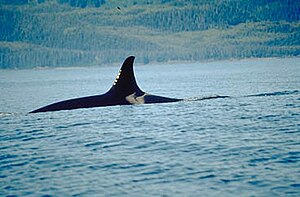You also have to remember that their rapid decline in the mid 60's was do to capture and they still managed to rebuild to a all time high in the mid 90's. Not all were SRKW but still a big hit to the Killer Whale population.
North Eastern Pacific captures

The first capture in the North Eastern Pacific occurred in November 1961. A collecting crew from
Marineland of the Pacific in
Los Angeles, took the 5.2 m (17 ft) orca to a tank at the aquarium, where she repeatedly crashed into the walls. She was named Wanda and died the following day.
[10][11] The next killer whale captured,
Moby Doll, had been harpooned and shot in 1964 and survived for three months when brought back for display to
Vancouver,
British Columbia.
[12] The third capture for display occurred in June 1965 when William Lechkobit found a 22-foot (6.7m) male orca in his floating salmon net that had drifted close to shore near
Namu, British Columbia. The killer whale was sold for $8,000 to
Ted Griffin, a
Seattle public aquarium owner. Named after his place of capture,
Namu was the subject of
a film that changed some people's attitudes toward orcas.
[13]
In October 1965,
Shamu, a very young, 14 foot (4.25m), 2000 lb (900 kg)
Southern Resident orca was captured by
Ted Griffin off Penn Cove,
Puget Sound to be a companion for the orca Namu at Griffin's Seattle public aquarium.
[14][15][16] Her name means ‘Friend of Namu’
[17] (alternately 'She-Namu').
[18] However, Shamu did not get along with Namu and so was sold to SeaWorld in San Diego in December 1965.
[19][20]
During the 1960s and early 1970s, nearly 50 killer whales were taken from Pacific waters for exhibition. The Southern Resident community of the Northeast Pacific lost 48 of its members to captivity. By 1976, only 80 killer whales were left in the community, which remains endangered. With subsequent captures, the theme parks learned more about avoiding injury during capture and subsequent care of killer whales, and discovered that they could be trained to perform tricks, making them a great attraction to visitors. As commercial demand increased, growing numbers of Pacific orcas were captured, peaking in 1970.
[21]
A turning point came with a mass capture of orcas from the L-25 pod in August 1970 at Penn Cove, Puget Sound off the coast of
Washington. The Penn Cove capture became controversial due to the large number of wild killer whales that were taken (seven) and the number of deaths that resulted: four juveniles died, as well as one adult female who drowned when she became tangled in a net while attempting to reach her calf. In his interview for the
CNN documentary
Blackfish, former diver John Crowe told how all five of the whales had their abdomen slit open and filled with rocks, their tails weighted down with anchors and chains, in an attempt to conceal the deaths.
[22] The facts surrounding their deaths were discovered three months later after three of the dead whales washed ashore on
Whidbey Island. Public concern about the welfare of the animals and the effect of captures on the wild pods led to the
Marine Mammal Protection Act being passed in 1972 by the
US Congress, protecting orcas from being harassed or killed, and requiring special permits for capture. Since then, few wild orcas have been captured in Northeastern Pacific waters.
[23][24]
Lolita, originally known as Tokitae, was a survivor of the Penn Cove captures. She was about six years old at time of capture and is now the oldest captive killer whale. Lolita is the subject of the documentary
Lolita: Slave to Entertainment, released in 2008.
[25] Various groups still argue that Lolita should be released into the wild.
[

